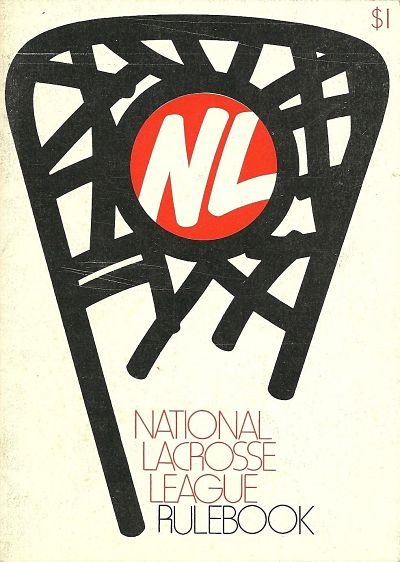Tombstone
Formed: 1974
Disbanded: February 13, 19761Shoihet, David. “Amen for professional lacrosse, financial problems prove fatal”. The Star (Montreal, QC). February 14, 1976
First Game: May 15, 1974
Last Game: September 29, 1975
Seasons: 2
States & Provinces: 6 (Maryland, Massachusetts, New York, Ontario, Pennsylvania, Quebec)
Leadership
Commissioner:
- October 1974 – February 1976: Gerry Patterson
Attendance
National Lacrosse League attendance information for the 1974 & 1975 seasons is spotty.
A nationally syndicated article by Brian Redman of The Washington Star Dispatch that ran in August 1975 stated that league-wide average attendance for the 1974 season was 4,968 per game, while 1975 league-wide figures stood at “around 4,700” late in the season.2Redman, Brian. “Fight Prospects Bring Out What Fans The Struggling Sport Can Draw, Keep Some Home.” The Sentinel-Star (Orlando, FL). August 17, 1975
A September 1975 article by David Shoithet of The Montreal Star posted final regular season average attendance figures for three of the six NLL clubs active in 1975:3Shoihet, David. “Patterson believes despite NLL doubts”. The Star (Montreal, QC). September 9, 1975
- Montreal Quebecois – league leader at 6,226 per game
- Long Island Tomahawks – 3,960 per game*
- Boston Bolts – 3,110 per game
*A September 1975 article by Jane Gross of Newsday in New York reported Tomahawks attendance at a different figure of 3,895 per contest.4Gross, Jane. “Tomahawks Look For Bigger Audiences”. Newsday – Suffolk Edition (Melville, NY). September 20, 1975
Trophy Case
National Lacrosse League Most Valuable Player
[etable]
Year, Player, Position, Team
1974, Paul Suggate, Defense, Maryland Arrows
1975, Ivan Thompson, Defense, Boston Bolts
[/etable]
Background
The National Lacrosse League was a professional box (indoor) lacrosse circuit active during the summers of 1974 and 1975. NLL clubs played in some of the major and historic hockey arenas in the Northeast and eastern Canada. The summer seasons conditions could be brutal for players and fans alike in buildings like the Boston Garden and Toronto’s Maple Leaf Gardens that lacked air conditioning.
Players could earn about $6,500 a year playing in the NLL. The league’s talent pool included a large number of Canadians, many of First Nations origin, and a handful of moonlighting ice hockey players. Two particular notables were Buffalo Sabres left winter Rick Dudley, who played for the 1974 NLL champion Rochester Griffins and future United States Men’s National Soccer Team head coach Bruce Arena who suited up for the Montreal Quebecois.
The league’s franchises were unstable, with several shutdowns and relocations during the NLL’s brief history. While teams in Maryland, Montreal and Philadelphia (especially) proved to be popular box office draws,by early 1976 only the Philadelphia and Maryland franchises were in financial condition to continue for a third season. NLL Commissioner Gerry Patterson announced the demise of the league on February 13, 1976.
The NLL of the 1970’s is not to be confused with today’s National Lacrosse League, which is a nationwide indoor league that traces its roots back to 1987. After several name changes, the modern day league adopted the National Lacrosse League name in 1998. The Philadelphia Wings franchise of the modern day NLL formed in 1987 and revived the name and updated the logo of the 1970’s Philadelphia Wings of the original NLL.
National Lacrosse League Franchise List
[etable]
Franchise, Years Active, Nations Cup Champions
Boston Bolts, 1975, None
Long Island Tomahawks, 1975, None
Maryland Arrows, 1974-1975, None
Montreal Quebecois, 1974-1975, None
Philadelphia Wings, 1974-1975, None
Quebec Caribous, 1975, 1975
Rochester Griffins, 1974, 1974
Syracuse Stingers, 1974, None
Toronto Tomahawks, 1974, None
[/etable]
National Lacrosse League Shop
[auction-nudge tool=”listings”]
##


5 Responses
In your 1975 Philadelphia Wings section it’s noted:
“One player – John Grant Sr. – returned from the original Wings of the 1970’s to see action for the new Wings. In later years, his son John Grant Jr.would also come to star for the Wings.”
John Grant Jr. never played for the Wings. He was drafted by the Buffalo Bandits in 1995 but chose to attend college. 4 years later (1999) he was drafted 1st overall by the Rochester Knighthawks.
Do you have videos of 1974-75 regular season games for purchase?
I would love to purchase the entire 1974-75 Nll season. If the videos ate available, please call me at 267-742-6777.
I watched the first live Phila wings game on Channel 29 announced by Gene Hart vs the Rochester Grifgins in 1974. The Griffins scored 9 breakaways after the Wings took a 2-0 lead
I can be reached at 267-742-6777.
Paul White
Hey Paul, we’re no longer in the memorabilia business. The site was sold back in February. We’ve slowly been going through and deleting the auction links. That being said, the former owner may still have these items available on eBay.
I would love to purchase the 1974 game, Rochester Griffins v Philadelphia wings, NLL, where Rochester scored nine breakaways after the wings took a 2-0 lead. I can be reached at 267-742-6777P